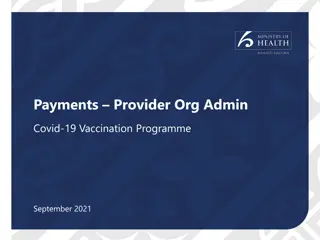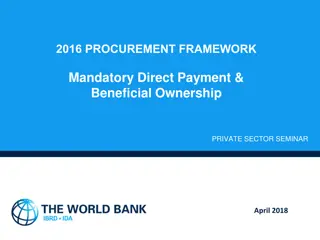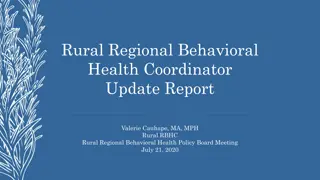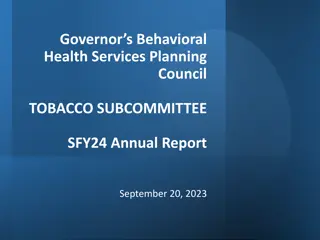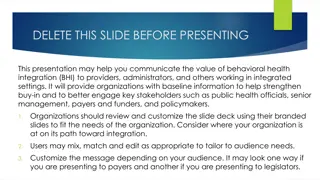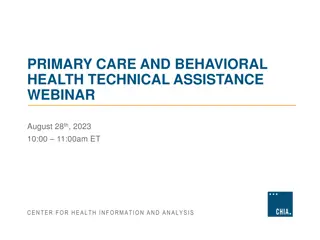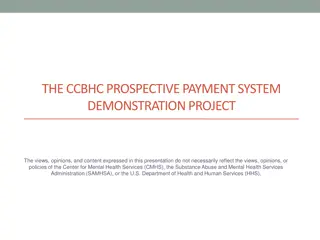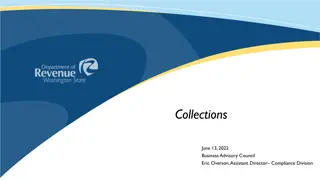Understanding Value-Based Payment in Behavioral Health
This PowerPoint template by The National Council for Behavioral Health aims to educate and prepare staff in behavioral health provider organizations for the shift to value-based payment (VBP). It covers the fundamentals of VBP, changes in healthcare payment systems, different payment methodologies, and the importance of continuous quality improvement. The template can be used for training sessions or presentations to help staff understand their role in VBP and adapt workflows.
Download Presentation

Please find below an Image/Link to download the presentation.
The content on the website is provided AS IS for your information and personal use only. It may not be sold, licensed, or shared on other websites without obtaining consent from the author. Download presentation by click this link. If you encounter any issues during the download, it is possible that the publisher has removed the file from their server.
E N D
Presentation Transcript
Introduction The National Council for Behavioral Health developed this PowerPoint template, Understanding Value- based Payment: A Primer for Staff, to support behavioral health provider organizations in their efforts to facilitate the shift to value-based payment (VBP). As VBP is increasingly being used by Medicare, state Medicaid programs, managed care organizations and private payers, it is critical that behavioral health provider organizations help educate and prepare their staff for the changes ahead. This PowerPoint template offers sample content organizations can use off-the-shelf, or modify and adapt, to teach clinicians and staff about the fundamentals of VBP and to help them understand their role in VBP. It provides foundational information about why health care payment systems are changing, what different payment methodologies entail and how providers may need to adapt workflows and practices. It discusses the vital role of continuous quality improvement and population health management in ensuring providers succeed in a VBP environment. Organizations can use this template to train staff through formal training sessions, lunch n learns, presentations at full staff or team meetings or other formats that may work best in your respective settings. The material can also be divided into shorter segments to accommodate limited meeting/training times. The template includes helpful tips for presenters and offers guidance on how organizations may want to adapt or tailor the information. These appear in the presenter s notes for each slide. As this is a primer, it is not intended to replace more comprehensive training that the organization may need to offer clinicians and staff on related topics, such as implementing population health management strategies or utilizing new health information technology. We hope you find this useful! Should you have questions or need assistance, please contact Mindy Klowden, Director, Training and Technical Assistance at MindyK@TheNationalCouncil.org . Additional resources related to value-based payment for behavioral health providers can be found at www.CareTransitionsNetwork.org
Acronyms CMS: Centers for Medicare and Medicaid Services CQI: Continuous Quality Improvement CQM: Clinical Quality Measure ED: Emergency Department FFS: Fee-for-Service PDSA: Plan-Do-Study-Act QI: Quality Improvement SBIRT: Screening, Brief Intervention and Referral to Treatment VBP: Value-based Payment
Understanding Value- based Payment Placeholder for your Agency s Logo A Primer for Staff
Why Are We Doing This Training? 1 2 3 Value-based payment is increasingly becoming the norm. New payment methodologies require new skill sets and competencies. We want clinicians and staff to feel prepared and supported.
VBP Opportunity for Behavioral Health VBP is a significant opportunity for providers of behavioral health services, given that: Total spending per person for individuals with a behavioral health diagnosis is nearly four times higher than for those without. 20 percent of Medicaid enrollees who have a behavioral health diagnosis account for almost half of total Medicaid expenditures. Many people with serious behavioral health disorders have a substantial number of comorbid acute or chronic medical conditions.
Fee-for-Service (FFS) vs. Value-based Payment (VBP) FFS: Incentive for Volume VBP: Incentive for Value Achieve outcomes Value Services/ Encounters Payment More cost- effective
The Drivers of VBP: The Quadruple Aim Population Health Experience of Care Per Capita Cost Provider Satisfaction
Examples of Common Quality Domains and Metrics Used in VBP Domains Sample Metrics Reducing overall health care costs (e.g., unnecessary or avoidable ED utilization and/or hospitalization/readmissions) % reduction in unnecessary or avoidable ED utilization and/or hospitalization Improving health outcomes/specific clinical quality measures Improvements demonstrated in hemoglobin A1C, hypertension or depression # days maximum between initial referral and appointment time Increasing access to care % of patients indicate they are satisfied or very satisfied Patient satisfaction % of patients screened for suicide risk, SBIRT or risk of falls/home safety Increasing safety and reducing risk
VBP and Population Health Management Population health management focuses on improving and maintaining the health of your entire patient population across the full continuum of care. It requires a shift from looking at the health care needs and outcomes of one individual patient, to managing the health of groups of patients. VBP aligns with the implementation of population health management as a way to improve health care quality and decrease costs. In practice, population health management might involve a) clinicians using standardized screening tools and entering data into a disease registry, b) quality improvement staff tracking outcomes on patients identified with a particular condition and c) care managers using targeted outreach to support patients most at risk.
Key Components of Population Health Management Define the population Identify gaps in care Stratify risk Engage patients Manage care Measure outcomes
Population health management often requires use of new tools and technology, such as: Disease registries that facilitate proactive identification and tracking, and management of individuals with certain health conditions who may require specific, targeted services. EHRs that facilitate data tracking for performance and quality improvement. Care management tools that support clinical decision- making and/or care coordination. Data analytics tools that support the clinic s ability to understand cost of care for a particular population.
Types of Value-based Payment Arrangements Pay for Performance Incentive Payments or Care Coordination/PCMH/Health Home Payments Shared Savings Two-sided/Shared Risk Population-based Payments: Full or Partial Capitation
Payment Reform Continuum Population-based Payments (Full or Partial Capitation) Two-sided or Shared Risk Flexibility for Use of Funds Shared Savings Pay for Performance or Incentive Payments Fee-for-Service Provider Risk and Accountability
Pay for Performance Services are billed fee-for-service, but provider qualifies for additional funds if certain benchmarks are reached. Example 1: % of patients seen within 7 days post hospitalization. Example 2: % of patients screened for depression. Requires strong data collection and reporting capabilities; continuous quality improvement processes in place. Payment typically received on the backside or upon completion of the contract deliverables.
Incentive Payments Services are billed fee-for-service, but provider qualifies for additional funds for offering a prescribed set of additional, non-billable services or for meeting pre- determined benchmarks. Example 1: Incentive payment tied to meeting NCQA Patient Centered Medical Home standards. Example 2: Incentive payment tied to offering care coordination services. Payment typically received on a per-member/per-month basis. Requires ability to track patients served according to pre-determined attribution methodology and demonstrate program requirements have been met.
Shared Savings Shared savings reward providers that reduce total health care spending on their patients below an expected level as set by the health plan. The provider is then entitled to a share of the savings. The goal is that the payer spends less on a patients treatment than it would have otherwise spent, and the provider gets more revenue than it would have just by billing. Provider qualifies for a percentage of overall health care savings achieved, typically paid upon completion of contract deliverables. Often tied to reduction in unnecessary ED utilization, hospitalization and/or readmissions. Requires access to claims data and strong data collection and tracking systems; enhanced population management capabilities.
Two-sided/Shared Risk Like shared savings models, providers benefit from a reduction in overall health care costs. However in a shared risk model, providers are also held financially liable if savings targets are not achieved. Typically the opportunity for upside financial gain is larger. Often tied to reduction in unnecessary ED utilization, hospitalization and/or readmissions. Requires providers to have financial reserves, strong financial forecasting capabilities and strong data analytics.
Population-Based Payments: Full or Partial Capitation Full Capitation: A provider organization, or group of organizations such as an ACO, receives a single fixed payment for the entirety of health care services a patient could receive. Typically paid as a per member per month for a given period of time. Example: Per member per month based for all health care services, including hospitalization, for an attributed patient population. Partial Capitation: the single monthly fee that is paid to the provider only covers a defined set of health care services (e.g., may exclude hospitalization or prescription medication). Example: Per-member/per-month payment for all outpatient mental health care needs for people with serious mental illness based on level of care. With either full or partial capitation, the provider assumes some of the insurer s role, such as utilization management. Requires ability to accurately predict patient behavior and service utilization, strong data analytics and sophistication with population health management.
How Does This Impact Front Line Staff Critical role in ensuring efficient workflows. Strong customer services = increased patient satisfaction/improved experience of care. May be asked to implement changes in intake or other workflow processes.
How Does This Impact Clinicians Need to become more familiar with what data is available and how to use it. Treat-to-target. Increased use of standardized assessment tools. Held accountable to new standards or outcomes. More involved in continuous quality improvement work. Use of risk stratification tools to help connect patients with needed services while being good stewards of finite resources. Some changes to documentation may be required to capture data necessary to meet targets. Potentially increased collaboration with other providers and care team members as well as QI staff.
How Does This Impact Administrators Invest in necessary health information technology infrastructure. Provide adequate staff training. Transparency around contract deliverables. Increased capacity around financial projections. Reinforce culture of learning and quality improvement.
How Does This Impact Quality Improvement Staff Likely will have expanded role and work more closely with clinicians. New or additional CQMs to track. Drive workflow/process mapping and use of PDSAs. Smaller clinics with limited or no QI staff may need to contract these services out, or rely more on clinicians (increased responsibility for data collection and input).
How Does This Impact Patients More opportunities to give input on patient satisfaction; advisory boards Greater engagement
How Will My Agency Help Me Prepare? Additional staff development opportunities to be offered. Opportunities to work in cross-functional teams and/or CQI teams. Increased access to information and transparency of data, including financial data and contract stipulations. Investment in health information technology and population health management tools such as registries, care management software and upgrades to the electronic health record. Supervisors/managers will both support and hold their teams accountable.
Additional Resources Big Ideas Fast (2018): Brief videos, tailored to specific audiences, that distill complicated concepts into key messaging in just a few minutes. Value-based Payments for Administrators Value-based Payments for Clinicians Creeping and Leaping from Payment for Volume to Payment for Value (2014): An overview of the service delivery and payment models that are emerging for behavioral health providers as health reform continues to unfold. HCP-LAN Alternative Payment Model (APM) Framework (2017): A framework designed by Health Care Payment Learning & Action Network to establish a common structure upon which payment reform progress can be measured. New York State Roadmap for Medicaid Payment Reform Annual Update (2017): A roadmap that defines what arrangements constitute value-based agreements in New York State, including best practices and lessons learned. Value-Based Payment Planning Guide (2017): A guide for provider organizations to create a systematic approach toward value-based payment transformation. Risk Stratification Tool and User Guide (2017): A tool that helps users take a population health management approach to both clinical care and business operations, and determine value as defined by patient health outcomes and cost of care.
Thank you! This resource, Understanding Value-based Payment: A Primer for Staff, was developed by the National Council for Behavioral Health with funding from the U.S. Department of Health & Human Services (HHS), Centers for Medicare & Medicaid Services (Funding Opportunity Number: CMS-1L1-15-003). Disclaimer: The contents provided are solely the responsibility of the authors and do not necessarily represent the official views of HHS or any of its agencies.



